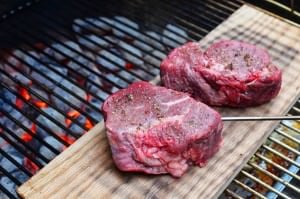Filet mignon is all about texture. It comes from the tenderloin, a muscle deep in the ribcage of the cow, that doesn’t see much work. The result is smooth and tender meat.
The downside of being all about texture? Tenderloin is bland. It doesn’t have the big, beefy flavor of other, more active muscles. I’m fixing that with an oak plank and blue cheese.
I serve the beef on top of a spring mix salad with blue cheese dressing - I love the bitter greens with beef - and topped the steaks with some of the blue cheese as a finishing touch.
The plank smokes the beef while it protects the thick steaks from the heat of the grill. My kids, who aren’t steak fans, were all over this one. I think the wood smoke sold it - tastes like bacon, they said. I tried to explain that it wasn't really a bacon flavor, and the difference between hickory and oak smoke. They stopped paying attention, like they always do when I start rambling on about cooking.
What’s that? You already stopped paying attention too? Sorry. I’m done. Here’s the recipe.
Recipe: Plank Grilled Filet Mignon with Blue Cheese Salad
Cooking time: 30 minutes
Equipment
- Oak Grilling Plank (roughly 1“ by 8” by 16")
- Grill (I use a Weber Kettle, like this one.)
Ingredients
- 4 (1 ½ inch to 2 inch thick) filet mignons (beef tenderloin steak)
- 2 teaspoons kosher salt
- 1 teaspoon fresh ground black pepper
- 4 ounces crumbled blue cheese
Salad
- 1 tablespoon sherry vinegar
- ½ teaspoon fresh ground black pepper
- ¼ cup olive oil
- 4 ounces crumbled blue cheese
- 3 ounces dried cranberries
- 5 ounces spring mix salad blend
Directions
1. Soak the plank
Put the plank in a large container, weigh it down, and cover with water. Soak for at least one hour, or up to overnight.
2. Season the beef
Sprinkle the filet mignons evenly with the salt and pepper. Let rest at room temperature for one hour, or up to overnight, refrigerated.
3. Set the grill up for indirect high heat
Set the grill up with two heat zones - one zone set to high heat, one zone set to no heat. For my Weber kettle, I light a chimney starter full of charcoal, wait for it to be covered with ash, then pour it in a thick pile covering half of the charcoal grate, leaving the other half of the charcoal grate empty.
4. Prep the salad
While the grill is preheating: in a large bowl, whisk the sherry vinegar, ground black pepper, and olive oil until they emulsify. Add the blue cheese and cranberries, then dump the spring mix on top. (Don’t toss the salad yet - wait until the steaks are cooked.)
5. Plank cook the steaks
When the grill is ready, remove the plank from the water, letting excess water drip off. Put the plank directly over the lit part of the grill, and leave it until it just starts to smoke. Move the plank to the unlit side of the grill, flip the plank over so the smoking side is facing up, and put the tenderloins on the plank. Cook with the lid closed until the tenderloins reach an 120°F internal temperature for medium-rare, about 20 minutes. (For rare, cook to 115°F; for medium, cook to 125°F)
6. Sear the steaks
Move the steaks from the plank to the direct heat side of the grill, with the undercooked side that was touching the plank facing up. Sear the steaks over direct high heat until browned on one side, about 2 minutes, rotating (but not flipping) after a minute to get a diamond pattern of grill marks. Remove the steaks to a platter, and immediately top with the blue cheese.
7. Serve
Let the steaks rest for 10 minutes. Toss the salad, slice the steaks, then serve by putting a big pile of salad on a plate, and topping with the sliced steak.
Notes
- A probe thermometer makes this recipe easy - stick the probe in the tenderloins on the plank, close the lid, and come back when the alarm goes off. I used a Thermoworks ChefAlarm - it’s a probe version of my beloved Thermapen, with an armored probe that has a better chance of surviving direct heat from charcoal. If you use a regular Polder style thermometer, the probe is only heat safe to 480°F or so. Above that the probe will burn out. The armored probe on the dual channel will keep it safe at higher temperatures, up to 650°F or so. (That said, it still shouldn’t sit over direct charcoal heat - charcoal can get up to 800°F.)
- I thought the plank would also give me a reverse searing effect, protecting the beef from the charcoal’s heat, and keeping it perfectly pink all the way through. That didn’t work out - the grill was too hot, and there was a small ring of overcooked beef around the outside of the steak. I may try this with indirect medium heat next time, about ¾ a chimney of charcoal, and rotate the plank after ten minutes to make sure one side of the beef doesn’t overcook. But these were delicious tenderloins - I’m not sure I’ll go to the extra effort.
What do you think? Questions? Other ideas? Leave them in the comments section below.
Related Posts:
Cedar Plank Salmon
Plank Grilled Brie with Honey and Thyme
*Enjoyed this post? Want to help out DadCooksDinner? Subscribe to DadCooksDinner using the RSS or Email options on the right, recommend DadCooksDinner to your friends, buy something from Amazon.com through the links on this site, or donate through my tip jar. Thank you.












mimi rippee says
Yum!
Charlie says
Glad to see somebody promoting these for something other than fish - I really like planking for big, thick cuts.